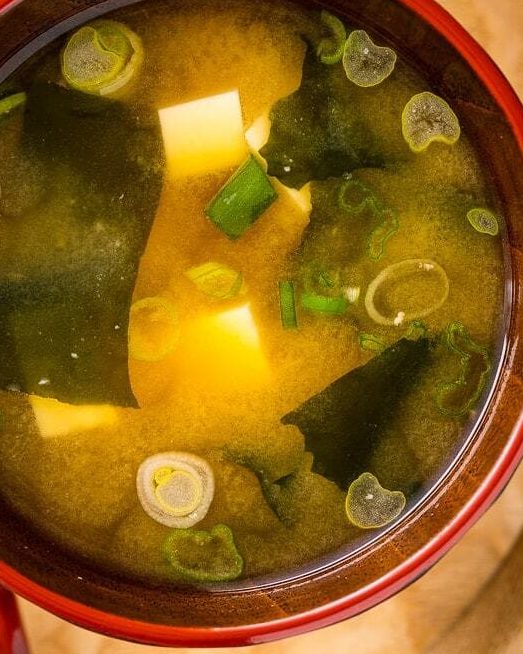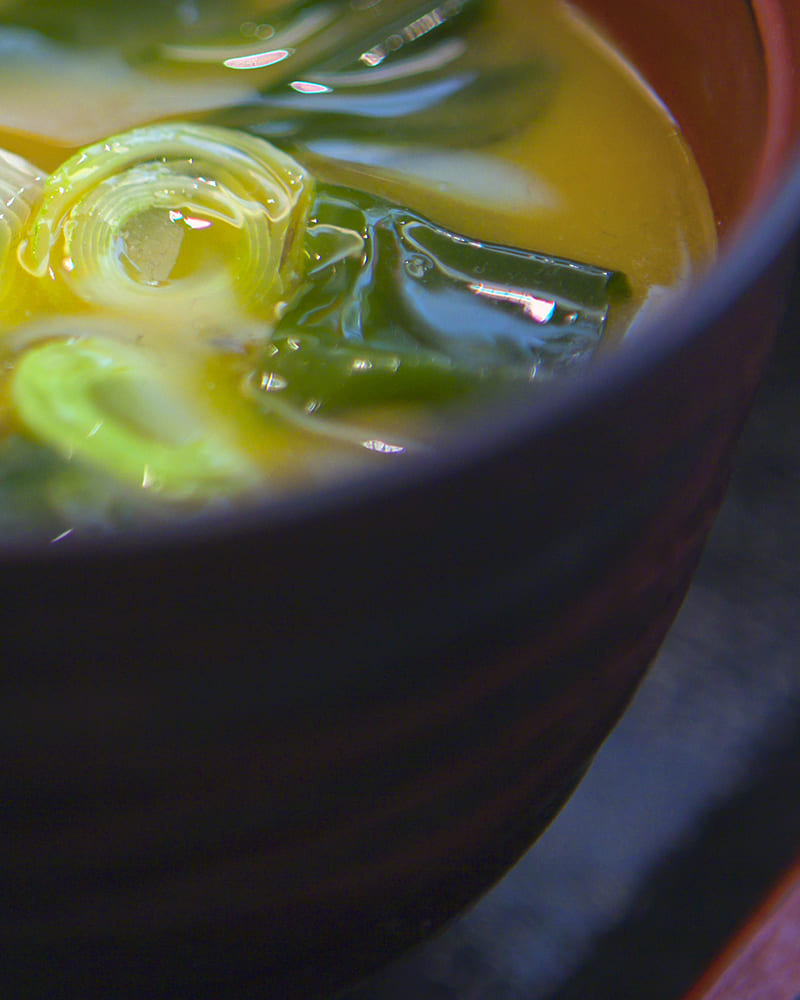If you’re a fan of miso soup, you’ll be happy to know that it has a long shelf life. But how long will it last in your fridge? And is there anything you can do to make it last even longer?
In this blog post, we will answer all of your questions about miso soup and give you some tips on how to make it last! Stay warm this winter with a bowl of delicious miso soup because now you’ll how long is Miso soup good for!
What Is Miso Soup?
If you’ve ever been to a sushi restaurant, you’ve probably seen miso soup on the menu. Miso soup is a traditional Japanese dish that is made by boiling miso paste in water. The paste is made from fermented soybeans, and it gives the soup its distinctive flavor. It is usually served with tofu, seaweed, and green onions, and it is often eaten as a starter or side dish.
In the following table, we have explained how long is Miso soup good for in the fridge, freezer and at room temperature.
| Miso Soup | Room Temperature | Fridge | Freezer |
| Cooked | Up to 2 hours | 3-5 days | Up to 6 months |
If you’re still wondering how long is Miso soup good for, wonder no more! Generally, homemade miso soup can be stored in the fridge for about 3-5 days, while store-bought soup will have a slightly longer shelf life of 5-7 days.
The shelf life of miso soup depends on a few factors, including:
- How it is stored?
- What ingredients are used?
For example, white miso paste has a shorter shelf life than red or yellow miso paste. The fermentation process that miso paste undergoes also affects its shelf life, with more fermented pastes having a longer shelf life. So, it is best to consume miso soup within a week of making it to ensure the best flavor and texture.
There are a few things you can do to extend the shelf life of your miso soup.
- First, make sure to store the soup in a airtight container in the fridge. This will help to prevent bacteria from growing.
- Second, add some extra miso paste to the soup before you seal it up. This will help to flavorsome and also acts as a natural preservative.
- Finally, don’t forget to add a date label to the container, so you know when the soup expires.
By following these simple tips, you can enjoy delicious miso soup for days to come.
How To Store Miso Soup Long Term In The Fridge?

Miso soup is a staple of Japanese cuisine, typically made with a base of miso paste, dashi broth, and tofu. However, miso soup can quickly go bad if not stored properly. The key to extending the shelf life of miso soup is to prevent the miso paste from coming into contact with oxygen.
Once exposed to air, the miso paste will start to break down, causing the soup to spoil. To avoid this, always store miso soup in an airtight container in the fridge. Alternatively, you can portion out individual servings of soup before adding the miso paste. This will prevent the rest of the soup from going bad if one serving is left unfinished.
Another important thing to note when storing miso soup is that it should not be boiled before being stored. Boiling the soup will cause the miso paste to break down and lose its flavor. Instead, the soup should be brought to a simmer and then removed from the heat. Once it has cooled, it can be transferred to a container that you can later put in the fridge.
With these simple precautions, you can store miso soup long-term in the fridge. Moreover, if you want to know how long is Miso soup good for, take a look at the table above.
How To Freeze Miso Soup?
If you’ve ever had miso soup, you know how delicious it is. But what if you could have it anytime you wanted, without going out or ordering it? You can, if you learn how to freeze miso soup! Miso soup is simple to make, and it’s also easy to freeze. Just follow these steps:
- Make the soup according to your recipe or using a store-bought mix.
- Let the soup cool completely. HOT liquids can break glass jars, so it’s important that the soup is at room temperature or cooler before freezing.
- Pour the soup into an airtight container. We usually prefer using freezer-safe plastic bags because they’re lightweight and don’t take up much space in my freezer. You could also use an ice cube tray, but I find that the miso doesn’t freeze well in individual cubes.
- Label the container with the date and contents. This will help you keep track of how long the soup has been frozen and ensure that you use it within a reasonable timeframe (I like to use mine within 3 months).
- When you’re ready to eat the soup, thaw it overnight in the refrigerator or place the container in a bowl of warm water until it’s thawed. You can gently reheat the soup on the stovetop or in the microwave – be careful not to overcook it, or the miso will become bitter.
There are a few things to keep in mind when freezing miso soup.
- It’s important to use a freezer-safe container. Glass jars work well, but you can also use plastic containers or freezer bags. Be sure to leave enough space at the top of the container for expansion.
- It’s best to portion out the soup before freezing it. That way, you can thaw and heat only as much as you need.
- Remember that frozen miso soup will have a slightly different texture than fresh soup. The tofu and vegetables may be softer, and the flavors will be less intense. Still, frozen miso soup makes a delicious and convenient meal on a busy night.
How To Thaw Frozen Miso Soup?

It’s happened to the best of us that sometimes we reach into the freezer for a nice bowl of miso soup, only to find that it’s frozen solid. If this happens to you gain, don’t despair, and know that there are 2 different ways to thaw your soup so that you can enjoy it as intended.
Method – 1
If you’re in a hurry, the quickest way to thaw frozen miso soup is to place it in a bowl and run hot water over it until the ice has melted.
Method – 2
If you’re not in such a rush, or if you don’t have access to hot water, you can thaw the soup by placing it in the refrigerator overnight.
Once it’s thawed, miso soup can be reheated on the stovetop over low heat until warmed through. If you find that your soup is too thick after thawing and reheating, you can thin it out with a little bit of water or vegetable broth. Moreover, if you want to know how long is Miso soup good for, check out the table above.
How Do You Know When Miso Soup Goes Bad?
Miso soup is gaining popularity in the West as a delicious and healthy option for a quick meal. But how can you tell when your Miso soup has gone bad?
- First, if the soup has an off-putting smell, it is best to discard it.
- Second, if the color of the soup has changed significantly, this is another indicator that it has gone bad.
- Third, if the texture of the soup is slimy or gritty, it is no longer safe to consume.
If you notice any of these signs, it is best to throw out the miso soup and start fresh. Moreover, if you’re not sure whether your Miso soup is still good, err on the side of caution and throw it out. After all, it’s better to be safe than sorry when it comes to food safety.
Conclusion
If you’re looking for a delicious, healthy soup that will last in your fridge for 3-5 days, miso soup is the perfect option. It’s the perfect quick and healthy meal to enjoy on a cold winter day, or any day really. Just make sure to store it in an airtight container and keep it in the fridge.

How Long Is Miso Soup Good For?
Instructions
How To Freeze Miso Soup?
- Make the soup according to your recipe or using a store-bought mix.
- Let the soup cool completely.
- Label the container with the date and contents.
How Long Is Miso Soup Good For?
- 3-5 days
Video
FAQs

Though it is often eaten as a part of a Japanese meal, miso soup is actually quite healthy and has several benefits.
- First, it is low in calories but high in protein, making it a great option for those looking to lose or maintain weight.
- Second, miso soup is rich in vitamins and minerals, including iron, calcium, and Vitamin B12.
- Third, the fermentation process that creates miso also creates beneficial probiotics that can help to improve gut health.
Whether you are looking to improve your health or just want a delicious soup to enjoy, miso soup is a great option. In addition, if you want to know how long is Miso soup good for, check out the table above. Now, let’s discuss some most frequently asked questions about miso soup and its shelf life.
How long can you store miso soup in fridge?
Miso soup can be stored in the fridge for 3-5 days. Make sure to store it in an airtight container to prevent the soup from spoiling. However, it’s important to note that the quality of the soup may degrade over time, so you may want to consider eating it sooner rather than later.
Does miso soup go bad in fridge?
Yes, it can go bad in the fridge. The fermentation process that creates miso soup produces lactic acid. This high level of lactic acid can cause the soup to spoil quickly, so be sure to check for any signs of spoilage before eating.
How long does miso last in fridge after opening?
The general rule of thumb is that miso will last in the fridge for about 2 months after opening. However, it’s always best to check the packaging to be sure. Miso is a fermented food, and as with all fermented foods. So even if it’s been opened for a while, it’s still worth using miso in recipes or just eating it plain. Just be sure to refrigerate it after opening and use within a few weeks.
Is it OK to reheat miso soup?
Yes, it is generally safe to reheat miso soup as long as it has been stored in a clean, covered container in the refrigerator. If you are reheating the soup on the stovetop, be sure to bring it slowly up to a simmer and then cook it for a few minutes until warmed through. You can also microwave the soup in a covered microwavable dish for 2-3 minutes on high power. Just be sure not to overcook it, or the miso will lose its flavor.
Maybe you’d like to read:
- How Long Does Celery Juice Last In The Fridge?
- How Long Does Ginger Last In The Fridge
- How long does Potato Soup last in the Fridge
- How long can Tomato Paste last in the Fridge

Welcome to my food site, RecipesAndPanty.com. I am a man who enjoys creating recipes and researching everything about food. This blog is dedicated to my grandmother because she gave me a taste for cooking.